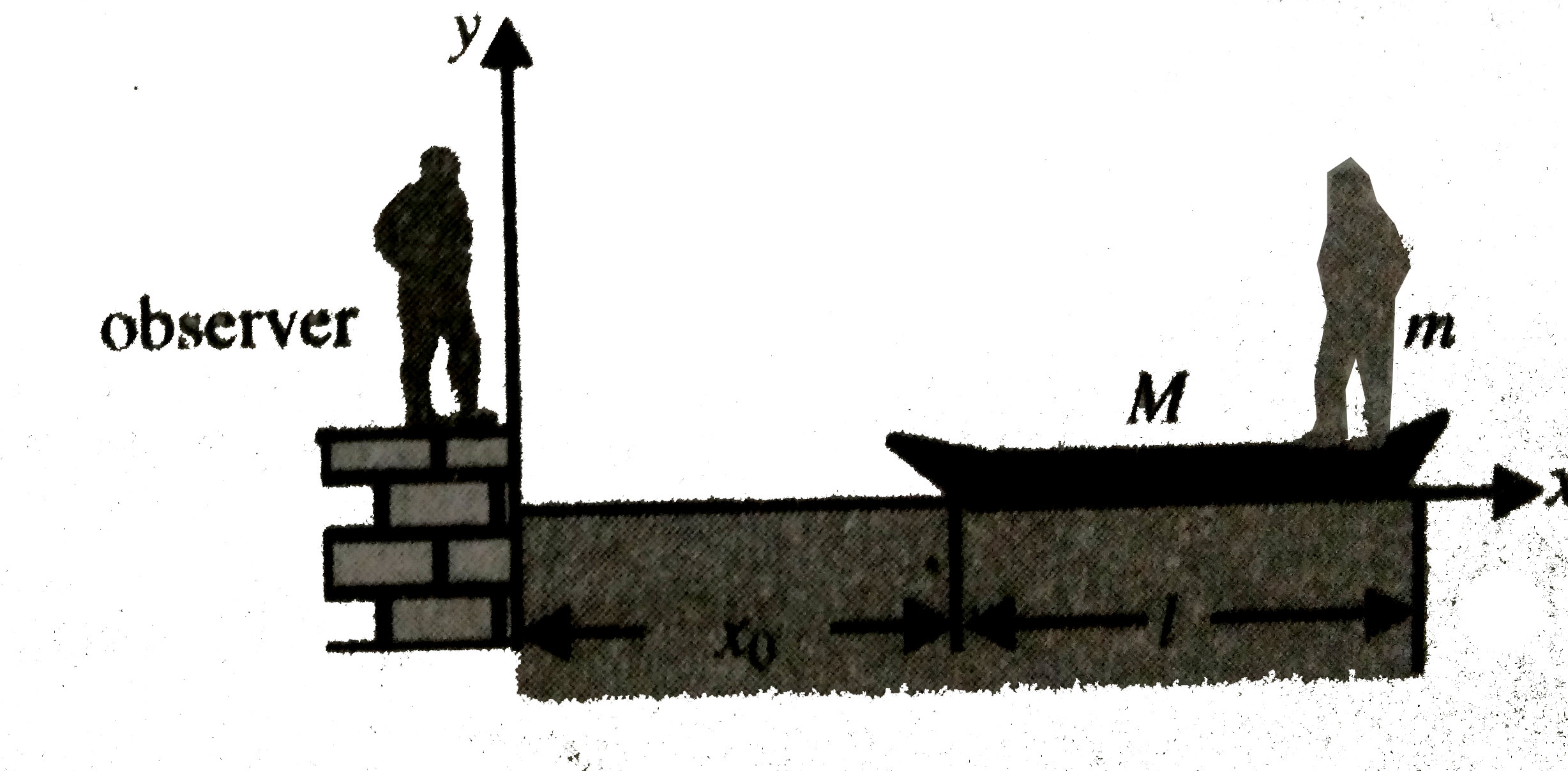A man of mass m runs without sliding from rest from one end of a boat of mass M and length l with an acceleration a relative to the boat. If the friction between water and boat is neglected find the

a. acceleration of CM of the system (M+m)
b. acceleration of the man and boat
c. position of man at the time when he reaches to other end of the boat
d. frictional force
e. work done by friction on boat.
f. total work done by friction.
g. velocities of man and boat when the man reaches other end of the boat.
h. work down by man
Consider 'boat and man' a system. No external force acts on the system in horizontal direction and initially the system is at rest i.e., the centre of mass is at rest. The acceleration of centre of mass will be zero.
There will to be an displacement of centre of mass.
b. Considering the FBD of man and boat. If we consider man and boat separately, the static friction between man and boat will be responsible for the motion of man and boat but as a whole the friction will be an internal force and will not move centre of mass of system
Let the acceleration and displacement of man be →amand→xm and that for boat be →aMand→xM.
→am=→am,M+→aM=−aˆi+aMˆi
=(aM−a)ˆi

But →acm=m→am+M→aM(m+M)
or 0=m(aM−a)ˆi+MaMˆi(m+M)
⇒→aM=ma(m+M)(ˆi) (towards right)
Hence am=ma(m+M)−a
⇒→am=Ma(m+M)(−ˆi) (towards left)
c. We know the displacement of CM
→xCM=m→xM+M→xM(m+M)
Here →xm=→xm,M+→xM=(−lˆi+xMˆi)
⇒→xm=(xM−l)ˆi
Hence xcm=O=m(xM−l)ˆi+MxMˆi(m+M)
⇒→–––(M)=−ml(m+M)(ˆi)[towards right]
and →xm=−Ml(m+M)(ˆi) [towards left]
position of man from observer at the time when the man reaches to other end of the boat.
→x=(x0+l)ˆi+→xm
=(x0+l)ˆi−Ml(m+M)ˆi=(x0+ml(m+M))ˆi
d. From FBD of man friction force acting on the man,
f=mam=m(ma(m+m))=Mma(m+M)
e. Work done by friction force on boat
(Wf)boat=→f→xm=[Mma(m+M)][ml(m+M)]
⇒(Wf)boat=Mm2al(m+M)2
f. As friction between man and boat in static nature and total work done by static friction force on the system should be zero
g. For finding the velocity of man when he reaches other end of the boat, we can use kinematics
Using v2m=u2m+2amxm=0+2(Ma(m+M))(Ml(m+M))
⇒v2m=(Mm+M)2.2al
Hence velocity of man vM=(Mm+M)√2al
Similarly velocity of boat vM=(mm+M)√2al
h. if we consider man + boat on system, friction will do no work on system as it in static nature. but we can se the kinetic energy of the system will increase. the question a rises here who does work to increase the kinetic energy of system. the answer is man. the man does this work through his internal energy to increase the kinetic energy of the system.
Using work energy theorem on the system we get
Wman+Wfriction=△K=K−Kf−Ki
We know Wfriction=0
Wman+0=(12mv2m+12MV2m)−0
Vman=12m[(Mm+M)22al]+12M[(m(m+M)22al]−0
⇒Wman=mMal(m+M)
Topper's Solved these Questions
- BOOK - CENGAGE PHYSICSCHAPTER - CENTRE OF MASSEXERCISE - Solved Examples13videos
CENTRE OF MASS
- BOOK - CENGAGE PHYSICSCHAPTER - CENTRE OF MASSEXERCISE - Exercise 1.120videos
CENTRE OF MASS
- BOOK - CENGAGE PHYSICSCHAPTER - CALORIMETRYEXERCISE - Solved Example13videos
CALORIMETRY
- BOOK - CENGAGE PHYSICSCHAPTER - DIMENSIONS & MEASUREMENTEXERCISE - Integer2videos
DIMENSIONS & MEASUREMENT
Similar Questions
Knowledge Check
- Question 1 - Select One or More
A man of mass m walks from end A to the other end B of a boat of mass M and length l. The coefficient of friction between the man and the boat is μ an neglect any resistive force between the boat and the water.
AIf the man runs at his maximum acceleration, the acceleration of the boat is (m/M)μg.BThe minimum time take by the man to reach the other end of the boat is √2MI(M+m)μgCIf man runs at his maximum acceleration the acceleration of boat is mm+MμgDThe minimum time take by the man to reach the other end of the boat is √2ml(M+m)μg - Question 2 - Select One
A boy of mass m is standing at one end of a boat of mass M and length l. The boy walks to the other end, the displacement of the
ACM is zeroBboat is mlM+mCboy is mlM+mDboat is mMl - Question 3 - Select One
A man of 80 kg attempts to jump from the small boat of mass 40 kg on to the shore. He can generate a relative velocity of 6 m/s between him and boat. His velocity towards shore is
A2 m/sB3 m/sC4 m/sD8 m/s
A man of mass m is standing on a plank kept on ground having mass m. There is no friction between the plank and the ground. If the man walks with an acceleration a w.r.t. the plank when calculate the acceleration of the plank w.r.t. the ground. Also calculate frictional force exerted by the plank on man.
 View Solution
View SolutionTwo men of masses 40 kg and 20 kg are standing on a boat of mass 100 kg. Length of boat is 20m. Neglect the friction between water and boat. Find the displacement of the boat when both the persons reach at middle of boat.
 View Solution
View SolutionA man is standing on a boat in still water. If he walks towards the shore the boat will
View SolutionA man is standing on a boat in still water. If he walks towards the shore the boat will
View SolutionA man is standing on a boat in still water. If he walks towards the shore, the boat will
View Solution

